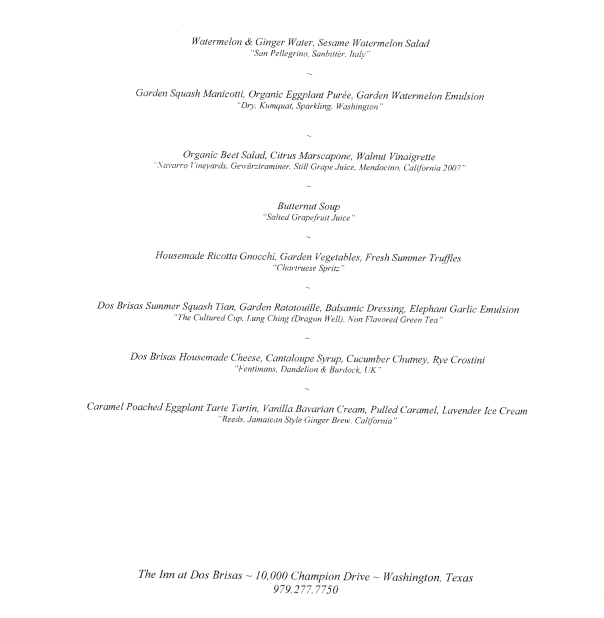Last weekend we had dinner at a rural resort between Austin and Houston. The Inn at Dos Brisas is a member of the Relais and Chateaux group, and the dining room has a five-star rating from Mobil, the only such in Texas. There would be a lot to say about this meal and the Inn, most of it very positive, but here I’m going to talk about what I thought was the most distinctive feature. Along with the tasting menu we had were offered both a standard wine pairing and, more unusually, a non-alcoholic beverage pairing. I’m a non-drinker, and I occasionally even feel left out in very wine-oriented fine dining contexts, so this really intrigued me. A good wine pairing should do several things, so let’s see how this not-wine version did. Before I get into the analysis, however, let me offer you the whole menu (the vegetarian tasting menu, as it happens).

So wine is supposed to enhance the food experience. At a minimum it adds an additional layer of complexity by adding a new element, and in a fine dining context that element brings along its own internal complexities. A wine paring has the additional advantage that it can, in principle, be more targeted. This all depends on the somelier doing a good job, of course; all that complexity can easily turn into a muddle. But if it works it can really elevate the experience. At least it can for those who have a more specific impression of the wines than alcohol burn.
The complexity and diversity of a non-alcoholic pairing are interestingly different. On the one hand, there is not the huge industry or long history associated with wine making. And most of the individual products are fresh; aged food are (all things being equal) more complex. On the other hand, the non-alcoholic menu can take the advantage of more fundamentally different kinds of beverage. Here we had bottled soft drinks, fruit juices, a tea, and the made-at-your-table “chartruese spritz” (disclosure: that last contained a tiny amount of alcohol). A wider range of infusions could have opened up things even more, but as it was there was a great range: different temperatures, levels of dryness, even differences in body. The pairing were all accurate. The very light, slightly bitter and herbal spritz, for instance, was a good counterpoint to the rich cream around the gnocchi while harmonizing with the garden vegetables in the dish. The only one I didn’t care for was the salted grapefruit juice, but I have to admit that I’d been so taken with the accompanying soup that finished it before I even tasted the glass.
Beyond the virtues of individual wine-food combinations, there are special attractions to the parings for a whole menu. Like many things in a good fine dining restaurant they provide experiences you couldn’t normally have at home. With both wine and non-wine, the sheer variety of eight separate beverages would be impractical in most home dining rooms. The small quantities involved also mean you can try vintages that might otherwise be out of reach; this is less of an issue for non-alcoholic beverages. (On the other hand, our menu was a bargain. Wine pairing typically start at a major fraction of the food price and go up from there.) A tasting menu is also an opportunity to maximize your access to a more sophisticated wine cellar than your local store’s, regardless of price. My home grocery store is one of the best in the country, and I could probably only get half the items on this menu (and conceivebly a fifth at the local tea emporium). Finally, a restaurant pairing often gives you running commentary from the somelier. Wine experts often work near the edge of self-parody, and it was initially odd to hear non-wine beverages being described in similar terms, but it became clear through the evening that this guy knew what he was talking about.
Non-alcoholic pairings certainly lack the tradition that wines have. Chefs are not trained to think in those terms. Customer demand is probably low, especially in restaurants that are places of special celebration anyway. And it can hardly be unimportant that there just isn’t the money to be made on non-alcoholic beverages. But we are in an age where fine dining recognizes a greater diversity of diets: raw in Los Angeles, celiac-friendly in England, vegetarian nearly everywhere. Why not a serious beverage menu without alcohol? Cheers to the Inn at Dos Brisas!